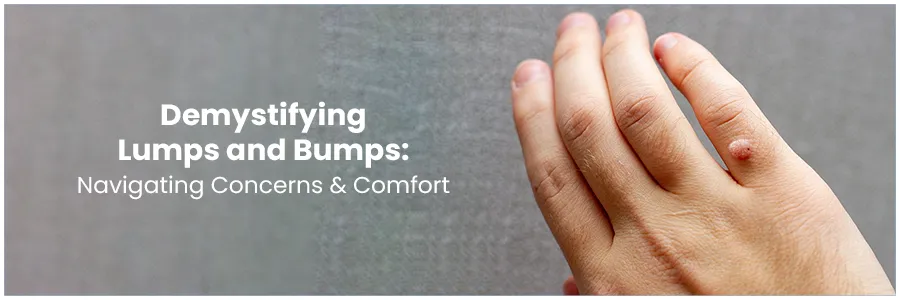Lumps and Bumps

Our bodies are intricate landscapes; occasionally, they develop unexpected formations like lumps and bumps. While discovering new growth in your body can be a cause for concern, it's important to remember that not all projections are created equal. In this blog, we'll explore the common types of lumps and bumps, discuss when to seek medical attention, and when you can breathe a sigh of relief.
Types of Lumps and Bumps
- Cysts: Cysts manifest as sacs filled with fluid, forming beneath the skin's surface. Typically, they possess a soft texture and are devoid of pain. These cysts have the potential to emerge anywhere on the body and typically pose no significant harm. Nevertheless, in instances where infection occurs or discomfort arises, seeking prompt medical attention is recommended.
- Lipomas: Lipomas are benign tumours made up of fat cells. They're typically found just beneath the skin and feel soft and rubbery. Lipomas are usually painless and don't require treatment unless they grow in size or become bothersome.
- Moles: Moles are pigmented skin growth that can be raised or flat. While most moles are harmless, changes in colour, size, shape, or irregular edges can signal a need for further evaluation to rule out skin cancer.
- Skin Tags: Skin tags are small, soft, and often flesh-coloured growths that hang off the skin by a thin stalk. They're familiar and generally harmless, but if they become irritated, they can be removed by a healthcare professional.
- Fibroadenomas: are common benign breast lumps that often occur in younger women. They're typically firm and smooth and move quickly under the skin. If you discover a lump in your breast, it's crucial to consult a healthcare provider for a proper examination.
- Abscesses: An abscess is a painful lump that forms when an area of tissue becomes infected. They can be accompanied by redness, warmth, and swelling. Spots require medical attention, as they may need to be drained and treated with antibiotics.
When to Seek Medical Attention
While most lumps and bumps are harmless, there are specific scenarios when medical attention is necessary:
- Rapid Growth: If a lump suddenly starts multiplying or changing in size, shape, or colour, it's time to consult a healthcare professional.
- Pain and Discomfort: If a lump becomes painful, tender, or causes discomfort, it must be examined, as it might indicate an underlying issue.
- Changes in Appearance: A medical expert should evaluate any sudden changes in a lump's appearance, texture, or colour.
- Family History: If you have a family history of cancer, it's wise to be cautious and examine any new growths, even if they seem benign.
- Persistent Symptoms: A medical evaluation is recommended if a lump doesn't go away after a few weeks or continues to bother you.
Introducing Our Dermatologists :
Consulting a dermatologist at Medicover Hospitals is an excellent choice if you're dealing with lumps and bumps on your skin. Dermatologists specialize in diagnosing and treating a wide range of skin conditions, including various types of growths, rashes, and abnormalities.
Conclusion:
The discovery of lumps and bumps on your body can be unsettling, but it's essential to approach them with a rational mindset. While many of these growths are harmless, it's crucial to consider changes and symptoms that could indicate a more serious issue. Regular self-examinations, awareness of your body's changes, and open communication with healthcare professionals can help you navigate the complexities of lumps and bumps, ensuring your peace of mind and well-being. Remember, it's always better to be safe than sorry when it comes to your health.
